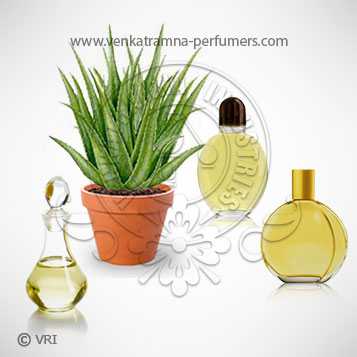
| Botanical Name | Aloe Barbadensis, Aloe Indica, Aloe Barbados, Aloe Vera |
| Common Name | Aloe, Indian Alces, Kumari, Ghirita, Gawarpaltra, Barbados Aloe, Curacao Aloe, Lu Hui |
| Country of Origin | South and South Western India |
| Solubility | Not Applicable |
| Specific Gravity | 0.976 – 0.991 @ 20°C |
| Optical Rotation | 20-46 @ 20°C |
| Refrective Index | 1.44663@ 72°F |
| PlantPart | Leaves,Fruit Peel. |
| Bland With | It contains a different compounds that are biologically active and includes anthraquinones, saccharides and prostaglandins as well as other constituents. |
| CAS No | 8007-75-8 |
| Flash Point | 136 °F |
| Extraction Method | Extraction |
Aloe vera essential oil is a good carrying agent for essential oils but it can also be effective on its own. Its healing properties are recognized worldwide and it is specially noted for healing and soothing effect on skin affliction and wounds. The special blend of aloe vera oil stimulates the body's immune system while being naturally hypoallergenic with about the same pH balance of the skin.
Aloe plants belong to the liliaceae family which contains over 200 genera. Aloe, with its different species composes 1/10th the size of the lily family. Aloeneae is the tribe of the liliaceae family to which the aloe genus belongs. According to different botanical sources, there are from 325 to 380 different species and varieties of Aloe. The oldest known picture of an Aloe plant is believed to have been shown in color in a manuscript prepared at Istanbul, Turkey. Records of ancient knowledge of the Egyptians about aloe vera is available to us through the everas papyrus which was written in the year 1552 B.C. and is kept now in the German University in Leipzig. Ancient records of the Egyptians, Arab, African, Asians and Americans have discussed the different uses and pathological cases in which Aloes were administered. Aloe was cultivated in Egypt thousands of years ago and was used by the people of the Mediterranean at least 400 years before Christ. Aloe is also mentioned in the Bible's New Testament. The Arabs had taken Aloe vera plants to India and the Indian people called it savari, a name from which the name savila (Spanish for aloe vera) might have been derived. The Indians also named Aloe Ailwa from which the Greek word alon might have been derived. Aloe was also mentioned in ancient Chinese transcripts. It was employed medicinally for eczematous skin conditions in China and India under the name Luhui in China and Musabbar in India. The Greeks knew Aloe through the Indians. The Greek physician Peter Pedanius Dioscoriades wrote about Aloe in his medicinal plant collection materna medica. Aloe was first illustrated in the Codex Aniciae Julianae which was written around the year 512 A.D. by Dichotomous. Aloe was also mentioned in the writings of the Latin writer, Aurelius Celsus, who wrote a book about medicine and called it De Medicina, which appeared for the first time in the year 1378. Aurelius Celsus was a well-known writer in agriculture and medicine. In America, Aloe was mentioned in Columbus' journals. The earliest record of using Aloe's bitter material as a drug in America was 1697.
Color : Colorless, White.,
Aroma : Aroma Treasures
Extracted from aloe vera plant, this oil helps to improve hydration and soothing all types of skin. It is known for its healing and anti-inflammatory properties. Aloe vera base oils are widely used for cosmetics, aromatherapy and more.
Apricot kernel oil is extracted from soft fleshy center of apricot skin, this oil is an excellent mosituriser and carrier base for various essential oils. The high content of the Oliec acid gives apricot greater affinity with skin compared with other oils.